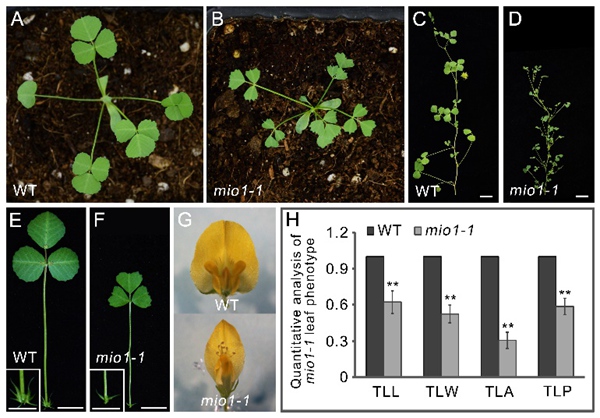Organ size is important for plants’ adaptation and survival and in influences the final yield and quality of crops. Legume plants are significant sources of plant-based protein for consumption by humans and animals. It is important to improve the yield of this crop to meet need of the people. However, it remains unclear what determines the organ size in legume plants.
In order to identify the key regulator of determining lateral organ size of legume plants, researchers from Xishuangbanna Tropical Botanical Garden (XTBG) conducted phenotypic and molecular studies on Medicago truncatula, a model legume plant.
The researchers identified the Medicago truncatula mutant mini organ1 (mio1) as a key regulator of organ size. The MIO1 encodes an F-box protein, SMALL LEAF AND BUSHY1 (SLB1), which was previously reported to control lateral branching.
The researchers screened the Tnt1 (a retrotransposon isolated from tobacco) retrotransposon insertion mutant population of the model legume for any organ size mutants. They then backcrossed the mio1-1 mutant with wild types and had phenotypic analysis.
They found that the sizes of leaf and flower (lateral organs) were markedly smaller in the mio1 mutant than the wild types. When the function of MIO1/SLB1was lost, the organ size of legume plants was severely reduced. However, when the MIO1/SLB1 was overexpressed, the organs of legume plants were enlarged.
“Therefore, the MIO1 gene is essential for proper organ size regulation in M. truncatula,” said ZHOU Shaoli, first author of the study.
Moreover, quantitative RT-PCR revealed that MIO1/SLB1 was highly expressed in leaves, floral organs, and immature seeds. Cellular and biochemistry analysis revealed that MIO1/SLB1 played a crucial role during lateral organ morphogenesis in M. truncatula and could form some ubiquitin ligase complex to repress cell division. MIO1/SLB1 positively regulates organ size mainly by promoting the process of primary cell proliferation during plant development.
“Our work reveals that MIO1/SLB1 plays a key role not only in the determination of lateral organ size, but also in the regulation of normal pulvinus development that is necessary for leaf movement in M. truncatula,” said Prof. CHEN Jianghua, principal investigator of the study.
“Our study is expected to help improve the biomass production and yield of legume crops and forages in agriculture,” added CHEN Jianghua.

